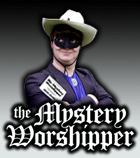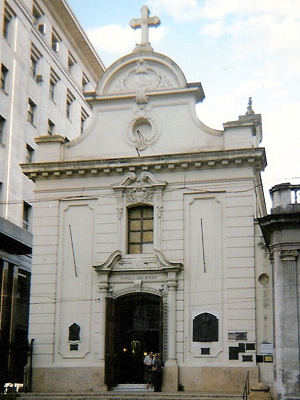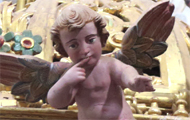| |
 |
 |
 |
| Comment on this report, or find other reports. |
 |
| Our Mystery Worshippers are volunteers who warm church pews for us around the world. If you'd like to become a Mystery Worshipper, start here. |
 |
| Find out how to reproduce this report in your church magazine or website. |
|
|
| 2534: Capilla
de San Roque, Montserrat, Buenos Aires, Argentina |
 |
 |
 |
Mystery Worshipper:
Augustine the Aleut.
The church: Capilla
de San Roque, Montserrat, Buenos Aires, Argentina.
Denomination: Roman
Catholic, Archdiocese
of Buenos Aires.
The building: A
smallish discrete chapel, once the mortuary chapel of the Franciscan
complex at the corner of La Defensa and Adolfo Ansina, it is
linked to the Basilica of San Francisco by a small ecclesiastical
museum. It dates from the 1750s and has the plain white exterior
of colonial baroque. The interior is as simple as South American
Catholicism gets, with whitewashed walls and a zen-like altar,
albeit with carved wooden statues of saints. Glass doors lead
onto the small plaza around which the basilica and museum are
placed; once the Plaza San Francisco, it has been renamed the
Plazoleta Héroes de Malvinas.
The church: I'm
not sure if it is a parish with a community or a city church
in the Anglican model, with its community being the office workers
in the vicinity. It bears the name of San Roque (Roch in French
or Rocco in Italian), an early 14th century French ascetic who
bore a birthmark in the shape of a cross. Roque walked from
town to town treating victims of the plague, but was exiled
after contracting the disease himself. He was saved from starvation
by a dog who brought him a loaf of bread and who licked his
sores, thus causing them to heal. He resumed the life of an
itinerant healer, but his illness had left him so debilitated
that he was mistaken for a common tramp and imprisoned, where
he died. Canonised in 1590 by Pope Gregory XIV, St Roque is
the patron saint of dogs, the gravely ill, and pilgrims.
The neighbourhood: The
chapel is at the more prosperous eastern end of the Montserrat
district, just to the south of the Casa Rosada (familiar to
fans of Evita) and the Plaza de Mayo, the centre of
demonstrations in Argentina. It is primarily an office area,
but there are some very tony apartments nearby, as well as some
very decrepit residential buildings. This is one of the oldest
parts of the city, busy with office workers in the day, and
crowds proceeding into or back from the nightlife of raffish
San Telmo to the south.
The cast:
As well as an older officiating friar, there was a younger one, as well as two other friars in street dress.
The date & time: Tuesday,
February 12, 2013, 5.30pm. [Editor's note: This report was filed
April 24, 2013.]
What was the name of the service?
Mass.
How full was the building?
The chapel might fit comfortably about 70, and with 30 women
and a dozen men it seemed quite full.
Did anyone welcome you personally?
I had not expected to get much notice as this is one of the
eight city churches in this barrio. But as I sat in my pew,
two parishioners stopped by to shake my hand and speak with
me, one slipping into English as my horrible accent outed me
as a foreigner. About five others nodded in greeting as they
passed.
Was your pew comfortable?
We were the beneficiaries of the best woodworkers of the 18th
century, who had prepared seats to suit worshippers at long
services. I parked myself near the statue of San Roque depicted
as he usually is, with his open sores and friendly dog at his
side. The saint is especially dear to Canadians, as in 1940–1942
the St Roch, a Royal Canadian Mounted Police schooner,
was the first vessel ever to complete a voyage through the Northwest
Passage in a west to east direction, and in 1950 was the first
ship ever to circumnavigate North America.
How would you describe
the pre-service atmosphere?
The older friar had parked himself a few pews in front of me,
and I soon realised that he was hearing confessions. A small
group of penitents sat in a nearby pew, rising and sliding over
as each confession was finished to sit by the priest, their
heads inclined, his hand on their shoulder. They spoke intently;
the priest listening for the most part, nodding and occasionally
speaking, then blessing the penitent at the end of it. The Argentines
sitting nearby turned this into a zone of silence, looking away
and making sure they were not able to hear. I tried to follow
their example.
What were the exact opening
words of the service?
There were some brief comments before the service began. I sometimes
wonder what they were, as the Argentinean Spanish dialect is
rather different from Spanish spoken elsewhere.
What books did the congregation use during the
service?
There were no books in the pews, although there were a few leaflets.
Everyone seems to know the liturgy by heart here.
What musical instruments were played?
We had a guitarist who strummed along during a gradual hymn.
During the communion, she played a guitar piece that sounded
vaguely like Bach to me, but was likely from the rich repertoire
of classical guitar, known but little to Canadians.
Did anything distract you?
Sounds from the city outside, coming through the glass doors at the back. The diesel engines of the Buenos Aires colectivo buses sounded a bit like asthmatic aircraft taking off.
Was the worship stiff-upper-lip, happy clappy, or what?
As an evening mass for tired office and restaurant workers and
some marginal street people, it was both business-like and reflective.
Exactly how long was the sermon?
5 minutes.
On a scale of 1-10, how good was the preacher?
8 – The elderly friar's pacing was good and he spoke with
dramatic flair. Sadly for me, his Spanish was inaccessible.
In a nutshell, what was the sermon
about?
I think he was speaking from the gospel of the day, but thatís
just a wild guess.
Which part of the service was like being in
heaven?
Watching the intensity of the confessions from my spot. Whatever
was being said, the penitents were serious, and fixed on the
confessorís advice.
And which part was like being in... er... the other place?
By this time in my month-long stay, I had become quite frustrated
with my inability to understand the local Spanish, so different
from the Castilian to which I had previously been accustomed.
What happened when you hung around after the service looking lost?
Everyone cleared out very quickly, the friars nattering away
to each other. Two parishioners came up to greet me: one prosperously
dressed older woman (pearls and a Prada bag) who shook my hand
and welcomed me to their casita de paz, (little house
of peace), and a very intense young man with a beard and a braided
pony-tail who, in the usual Argentine manner of greeting, hugged
me and kissed me on the cheek.
How would you describe the after-service
coffee?
Buenos Aires boasts the best coffee in the world, so I took
a cortado (espresso with a splash of milk) in the café
attached to the film-makersí university a few blocks down as,
at 6.30 pm, it was far too early to get dinner.
How would you feel about making this church your regular (where 10 = ecstatic, 0 = terminal)?
8 – If I were an office worker in this part of town, I
could see how San Roque could become a regular stop, although
it would be nice to understand what was being said. The guitarist
was so very good, her work would bring in atheists by the dozen
if they but knew of it – I have heard so many awful guitars
in churches over the years that this bit of musical magic still
remains with me.
Did the service make you feel glad to be a
Christian?
The intensity of life in this troubled city and country is such
that greetings and even the sharing of the peace seem to have
no falseness about them.
What one thing will you remember about all this in seven days' time?
The confession ritual, foreign to most Anglicans except in theory,
but clearly very meaningful for parishioners in this extraordinary
and turbulent city. |
|
|
 |
 |
 |
| We rely on voluntary donations to stay online. If you're a regular visitor to Ship of Fools, please consider supporting us. |
 |
 |
 |
| The Mystery Pilgrim |
 |
| One of our most seasoned reporters makes the Camino pilgrimage to Santiago de Compostela in Spain. Read here. |
 |
 |
 |
| London churches |
 |
| Read reports from 70 London churches, visited by a small army of Mystery Worshippers on one single Sunday. Read here. |
| |
|
|
|
|


